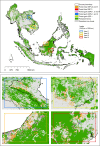The future of Southeast Asia's forests
- PMID: 31015425
- PMCID: PMC6478739
- DOI: 10.1038/s41467-019-09646-4
The future of Southeast Asia's forests
Erratum in
-
Author Correction: The future of Southeast Asia's forests.Nat Commun. 2023 Aug 30;14(1):5290. doi: 10.1038/s41467-023-41060-9. Nat Commun. 2023. PMID: 37648690 Free PMC article. No abstract available.
Abstract
While Southeast Asia's forests play important roles in biodiversity conservation and global carbon (C) balance, the region is also a deforestation hotspot. Here, we consider the five shared socioeconomic pathways (SSPs) to portray a range of plausible futures for the region's forests, employing a state-of-the-art land change modelling procedure and remotely sensed data. We find that by 2050 under the worst-case scenario, SSP 3 (regional rivalry/a rocky road), the region's forests would shrink by 5.2 million ha. The region's aboveground forest carbon stock (AFCS) would decrease by 790 Tg C, 21% of which would be due to old-growth forest loss. Conversely, under the best-case scenario, SSP 1 (sustainability/taking the green road), the region is projected to gain 19.6 million ha of forests and 1651 Tg C of AFCS. The choice of the pathway is thus critical for the future of the region's forests and their ecosystem functions and services.
Conflict of interest statement
The authors declare no competing interests.
Figures




References
-
- DeFries R, Hansen A, Newton AC, Hansen MC. Increasing isolation of protected areas in tropical forests over the past twenty years. Ecol. Appl. 2005;15:19–26. doi: 10.1890/03-5258. - DOI
-
- Bierregaard, R. O., Jr, Lovejoy, T. E., Kapos, V., dos Santos, A. A., Hutchings, R. W. The biological dynamics of tropical rainforest fragments. BioScience42, 859–866 (1992).
-
- Baccini A, et al. Estimated carbon dioxide emissions from tropical deforestation improved by carbon-density maps. Nat. Clim. Chang. 2012;2:182–185. doi: 10.1038/nclimate1354. - DOI
Publication types
LinkOut - more resources
Full Text Sources
Miscellaneous

